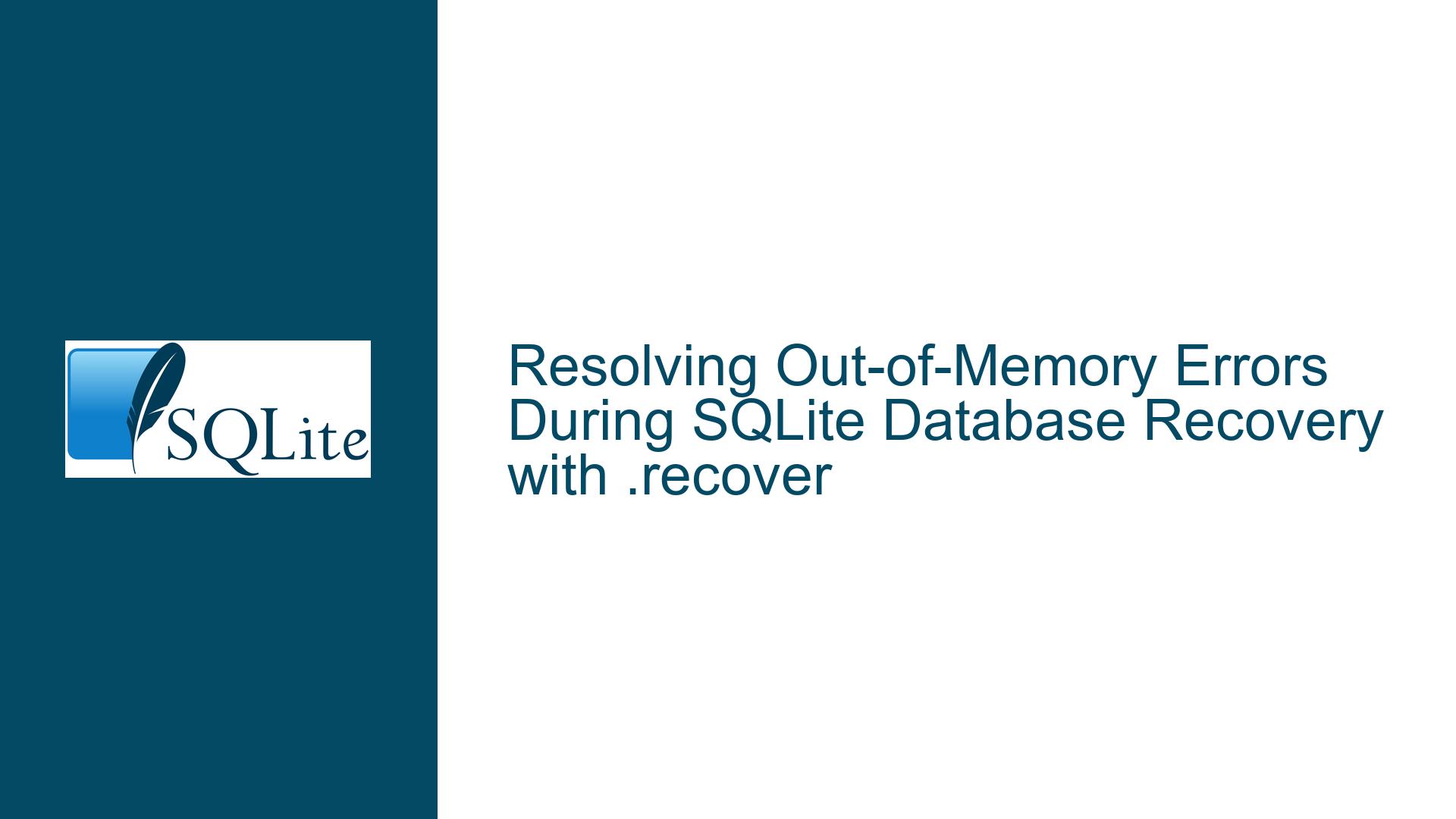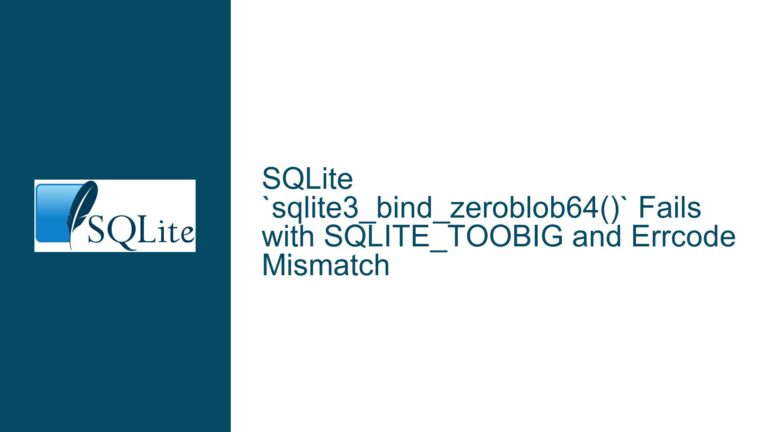Resolving Out-of-Memory Errors During SQLite Database Recovery with .recover
Understanding Out-of-Memory Failures in SQLite Database Recovery Operations
Issue Overview
When attempting to recover a corrupted SQLite database using the .recover command, users may encounter an "out of memory" (OOM) error. This occurs even when using a 64-bit version of the sqlite3.exe command-line interface (CLI), where memory address space limitations are theoretically absent. The error is counterintuitive because system resource monitors show the sqlite3.exe process consuming only a fraction of available memory (e.g., 6 MB to 50 MB), while the database file itself is relatively small (e.g., 142 MB to 300 MB). After applying patches or workarounds to resolve the OOM error, additional errors such as "too many columns on lost_and_found" may surface during recovery attempts, indicating deeper schema corruption.
The .recover command is designed to salvage data from severely damaged databases by reconstructing SQL statements from raw database pages. However, its operation involves intensive memory allocation to parse fragmented or inconsistent structures within the corrupted file. The OOM error arises not from global memory exhaustion but from localized failures in allocating memory blocks during specific phases of the recovery process. These failures are often triggered by malformed database pages or incorrect metadata that mislead the recovery algorithm into requesting unrealistically large memory buffers.
Diagnosing Memory Allocation Failures and Schema Corruption
Possible Causes
Misinterpretation of Corrupted Database Metadata:
SQLite relies on internal B-tree structures and page headers to navigate the database file. Corruption in these regions—such as invalid page counts, incorrect cell offsets, or garbled schema records—can cause the.recovercommand to miscompute buffer sizes. For example, a corrupted page header might report a cell size of 4 GB instead of 4 KB, leading to an impossible memory allocation request.64-Bit Memory Addressing Limitations:
While a 64-bitsqlite3.execan address vast memory spaces, the SQLite library enforces internal limits on memory usage to prevent runaway allocations. Parameters such asSQLITE_MAX_MEMORY(default: 2 GB) orSQLITE_MAX_PAGE_COUNT(default: 1073741823) may constrain memory usage during recovery. If the.recovercommand encounters a sequence of corrupted pages that collectively exceed these limits, an OOM error is raised regardless of system memory availability.Recovery Logic Bugs in Specific SQLite Versions:
The SQLite development team identified a defect in the.recoverimplementation (fixed in commit988c3179e978a3a6) where certain types of database corruption could trigger infinite memory allocation loops. This bug was unrelated to the database size or available memory and instead stemmed from incorrect handling of "lost-and-found" rows—orphaned data pages that the recovery process attempts to reintegrate into the schema.Schema Corruption Cascading into Runtime Errors:
After resolving the OOM error, users may encounter "too many columns" errors during recovery. This indicates that the.recovercommand successfully parsed some database pages but encountered a table definition with more columns than SQLite’s compile-time limit (SQLITE_MAX_COLUMN, default: 2000). Such corruption often arises from index leaf pages being misclassified as table rows or vice versa.
Mitigating Memory Errors and Recovering Corrupted Databases
Troubleshooting Steps, Solutions & Fixes
Step 1: Verify SQLite Version and Build Configuration
Begin by confirming that the 64-bit sqlite3.exe in use includes the latest fixes for recovery-related memory errors. Execute:
sqlite3 --version
Check if the version date is after November 29, 2023, or includes commit 988c3179e978a3a6. If not, obtain an updated build from the official SQLite website or trusted repositories like Nalgeon’s precompiled binaries.
Step 2: Build a Custom 64-Bit CLI with Patched Recovery Logic
If precompiled binaries are unavailable or outdated, compile the CLI from source:
- Download the SQLite amalgamation source code.
- Apply the patch from commit
988c3179e978a3a6tosqlite3.c. - Compile using a 64-bit C compiler (e.g., GCC, MSVC):
gcc -DSQLITE_MAX_MEMORY=5368709120 -DSQLITE_MAX_PAGE_COUNT=2147483646 -O2 shell.c sqlite3.c -o sqlite3.exeAdjust
SQLITE_MAX_MEMORYandSQLITE_MAX_PAGE_COUNTto raise memory ceilings.
Step 3: Use Alternative Recovery Methods
If .recover continues to fail, employ these strategies:
Partial Extraction via
.dump:
Run.dumpto generate SQL statements for intact schema objects and tables. Redirect output to a file:.output recovered.sql .dumpEven if the command aborts, the partial dump may contain salvageable data.
Leverage
sqlite3_analyzer.exe:
This tool generates a report on database structure, including page-level details. Use it to identify corrupted regions:sqlite3_analyzer.exe corrupted.db > analysis.txtLook for anomalies like "freelist leaf count" mismatches or invalid "overflow page" chains.
Third-Party Recovery Tools:
Tools likesqlean(from Nalgeon) or commercial solutions (e.g., SQLite Database Recovery by DiskInternals) bypass SQLite’s built-in recovery logic, offering alternative extraction methods.
Step 4: Address Schema Corruption Errors Post-Recovery
If recovery succeeds but schema errors persist (e.g., "too many columns"), manually edit the generated SQL dump:
- Open
recovered.sqlin a text editor. - Locate
CREATE TABLEstatements for thelost_and_foundtable. - Reduce the number of columns to below 2000, prioritizing critical data columns.
- Reimport the modified SQL into a new database:
sqlite3 new.db < recovered.sql
Step 5: Engage SQLite Developers for Deep Corruption Analysis
When confidentiality permits, share a sanitized copy of the corrupted database with the SQLite team via [email protected]. Include steps to reproduce the error and any observed symptoms. This aids in identifying edge cases in recovery logic.
Step 6: Implement Preventive Measures for Future Recovery
- Regular Backups with
VACUUM INTO:
UseVACUUM INTO 'backup.db'to create compressed, integrity-checked copies of the database. - Enable Write-Ahead Logging (WAL):
WAL mode reduces the likelihood of corruption during crashes. - Periodic Integrity Checks:
RunPRAGMA integrity_check;to detect early signs of corruption.
By systematically addressing memory allocation constraints, applying patches, and combining multiple recovery techniques, users can maximize data extraction from corrupted SQLite databases while minimizing the risk of OOM failures.






